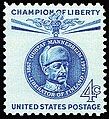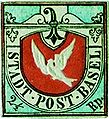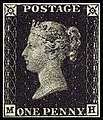Portal:Philately
| Philately portal | WikiProject Philately |
The Philately Portal
Philately is the study of revenue or postage stamps. This includes the design, production, and uses of stamps after they are issued. A postage stamp is evidence of pre-paying a fee for postal services. Postal history is the study of postal systems of the past. It includes the study of rates charged, routes followed, and special handling of letters.
Stamp collecting is the collecting of postage stamps and related objects, such as covers (envelopes, postcards or parcels with stamps affixed). It is one of the world's most popular hobbies, with estimates of the number of collectors ranging up to 20 million in the United States alone.
Bristol Customshouse and Post Office is a historic two-story rectangular Italian palazzo style brick building that was used as a post office and customshouse in Bristol, Rhode Island, United States. The land for the site was acquired for $4,400. The building was designed by Ammi B. Young and completed in 1858 for a cost of $22,135.75. The building roughly measures 46 feet (14 m) by 32 feet (9.8 m) and is constructed of deep red brick and has three arched openings on each of its sides and stories that are lined with sandstone moldings. The archways protrude from the side of the building and the center archway serves as the first floor with the adjacent archways housing large windows that are barred with iron. As it typical of the style, the second floor is more elaborate with a shallow balcony of iron supported by iron brackets and the paneling of the upper facade's surmounting entablature is elaborately decorative. The sides and rear are similar to the front facade, but include blind recesses and the molding is of a browner sandstone.
The building was abandoned in 1962 and acquired by the Young Men's Christian Association (YMCA) in 1964. The YMCA has an adjacent structure and used the building as an ante-space until 1990. Currently, the building is used as offices. The Bristol Customshouse and Post Office is historically significant as it is an example of the Italian palazzo mode of architecture. The building was added to the National Register of Historic Places in 1972. (Full article...)
Selected article -

Ralph Allen (c. 1693 – 29 June 1764) was a British postmaster, merchant and philanthropist best known for his reforms to Britain's postal system. Born in St Columb Major, Cornwall, he moved to Bath, Somerset to work in the municipal post office, becoming its postmaster by 1712. Allen made the system more efficient and took over contracts for the British mail service to cover areas of England up to the Anglo-Scottish border and into South Wales.
He purchased local stone mines from his postal profits and had Prior Park built as his country house to show off the versatility of Bath stone, using the old post office as his townhouse. Working alongside architect John Wood, the Elder, the stone Allen mined was heavily used in construction work for development works in Bath. However, the mines did not consistently make a profit and he subsidised them from his postal profits. (Full article...)
Selected images
Did you know (auto-generated)

- ... that working at a post office was how Derrick Harden became an NFL player?
- ... that James Diossa rescued the only public library and post office in Central Falls, Rhode Island, when the city went into bankruptcy?
- ... that after Irish post office clerk Maureen Flavin Sweeney reported worsening weather conditions, Dwight D. Eisenhower agreed to postpone D-Day by 24 hours?
- ... that both of Karl R. Free<nowiki>'</nowiki>s New Deal-era U.S. post office murals with Native American subjects have been challenged as offensive?
- ... that a new Christmas stamp that debuted in the 350-person town of Bethlehem, Georgia, in 1967 got so much attention that the two-employee post office had to hire forty-three temporary workers?
- ... that an investigation into the Royal Oak post office shootings led one congressman to accuse the Postal Service of having been "asleep at the switch"?
General images -
Selected stamp -
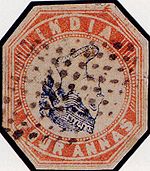
The Inverted Head Four Annas of India is a postage stamp prized by collectors. The 1854 first issues of India included a Four Annas value in red and blue. It was one of the world's first multicolored stamps; the Basel Dove preceded it by nine years. However, an invert error occurred during production, showing the head "upside down." (Full article...)
List articles

- List of philatelists
- List of most expensive philatelic items
- List of postage stamps
- Lists of people on postage stamps (article) • (Category page)
- List of entities that have issued postage stamps (A–E)
- List of entities that have issued postage stamps (F–L)
- List of entities that have issued postage stamps (M–Z)
- List of postal services abroad
- Timeline of postal history
Related portals
Topics
Categories
WikiProject
![]() WikiProject Philately organizes the development of articles relating to philately. For those who want to skip ahead to the smaller articles, the WikiProject also maintains a list of articles in need of improvement or that need to be started. There are also many red inked topics that need to be started on the list of philatelic topics page.
WikiProject Philately organizes the development of articles relating to philately. For those who want to skip ahead to the smaller articles, the WikiProject also maintains a list of articles in need of improvement or that need to be started. There are also many red inked topics that need to be started on the list of philatelic topics page.
Selected works
- Williams, Louis N., & Williams, Maurice (1990). Fundamentals of Philately {revised ed.). American Philatelic Society. ISBN 0-9335-8013-4.
{{cite book}}: CS1 maint: multiple names: authors list (link) - Hornung, Otto (1970). The Illustrated Encyclopedia of Stamp Collecting. Hamlyn. ISBN 0-600-01797-4.
- Stuart Rossiter & John Fowler (1991). World History Stamp Atlas (reprint ed.). pub: Black Cat. ISBN 0-7481-0309-0.
Wikimedia
The following Wikimedia Foundation sister projects provide more on this subject:
-
Commons
Free media repository -
Wikibooks
Free textbooks and manuals -
Wikidata
Free knowledge base -
Wikinews
Free-content news -
Wikiquote
Collection of quotations -
Wikisource
Free-content library -
Wikiversity
Free learning tools
Other Portals
Sources
- ^ "Philatelic Collections: General Collections". British Library. 2003-11-30. Archived from the original on 30 June 2011. Retrieved 2011-01-16.






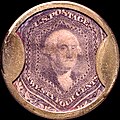





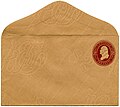
![Image 11Unissued 1956 £1 Jamaican chocolate and violet, the first stamp designed for Queen Elizabeth II. Held in the British Library Crown Agents Collection.[1]](http://upload.wikimedia.org/wikipedia/commons/thumb/9/9b/Stamp_Jamaica_1956_unissued_1sh.jpg/120px-Stamp_Jamaica_1956_unissued_1sh.jpg)








